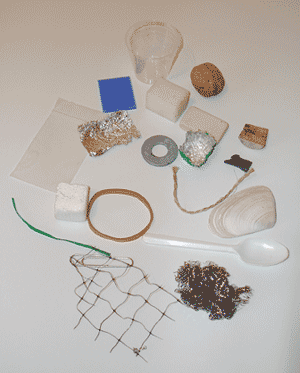| Approach:
Team |
Level:
Year 4 |
|
| Focus:
Properties
of materials/classification
|
 |
284Kb |
|
Resources:
Instruction card,
recording sheet, 8 meat trays, 2 magnets, 2 jugs of water,
2 bags of 20 different materials:bag tie, blue card, cork,
eraser, foam, foil case, netting, paper clip, plastic bag, polystyrene,
rubber band, sample cup, shell, spoon, steel wool, stone, string,
tin foil, walnut, washer |
|
| Questions/instructions:
In
this activity you are going to work together. Here is a bag of different
objects. The objects are all muddled up in one bag. Soon, I am going
to ask you to sort them into different groups.
Show students bag of materials.
There are many different ways that we can group objects. You will
need to think carefully about how you will group these objects.
Think about what materials they are made of and what is special
about each object. Think about what they look like and what they
feel like. You can also test the objects to see what you can learn
about them. We have some water and a magnet that you can use for
this. You need to put these objects into four different groups,
and then say why the objects in each group belong together.
First of all I want you to work in pairs. [A1 and A2] are to work
together and [A3 and A4] are to work together. Talk with your partner
about how you are going to group your objects. Talk about why some
belong together. What is special about them? Place your different
groups on the trays. I will give you a few minutes to group your
objects. Then I will ask you to tell the others what is special
about each group. Here is an instruction card to help you. |
 |
Read the instruction card.
Here is your equipment for you and your partner to work with.
Give each pair an instruction card, jug of water, a magnet,
4 trays and bag of objects. Allow time.
Now I would like you to show the others how you grouped your objects.
Tell us what is in each group and what is special or different about
that group. I will write down what is in each group when you are
ready.
Allow time. Record answers after pairs have shared.
Put 1 set of equipment aside, and mix other set for giving
to team.
|
|
Now
I want you to work as a group. This time you have one set of objects.
As a team, decide on what is the best way to group these objects
into five groups. Put your groups on the trays,
Give students instruction card, 1 set of objects and 5 trays.
Remember you need to think about what objects belong together.
What is special about each group? Why is it different from the other
groups? You have a few minutes to group your objects. Then I will
ask you to tell me about your groups.
Allow time. Record group answers |
|
|
%
responses
2003 ('99) |
| y4
|
Judgements
based on team decisions:
|
Descriptions
of groups – |
|
| group
1: |
all
items clearly fit description |
18
(19) |
items
fit description quite well |
71
(69) |
| group
2: |
all
items clearly fit description |
16
(21) |
items
fit description quite well |
76
(69) |
| group
3: |
all
items clearly fit description |
15
(19) |
items
fit description quite well |
76
(71) |
| group
4: |
all
items clearly fit description |
14
(17) |
items
fit description quite well |
72
(67) |
| group
5: |
all
items clearly fit description |
24
(22) |
items
fit description quite well |
62
(59) |
Coherence
of groups –
good: all
items in group fit together and none in other groups fit
moderate: all items in group fit but one or more in other
groups also fit |
|
|
group
1: |
good
|
18
(22) |
moderate
|
49
(50) |
| group
2: |
good |
12
(22) |
moderate |
57 (54) |
| group
3: |
good
|
18
(28) |
moderate
|
50
(46) |
| group
4: |
good
|
17
(17) |
moderate
|
51
(48) |
| group
5: |
good |
27
(26) |
moderate
|
46
(46) |
|
|
|
Total
score:
|
20–25
|
3
(9) |
16–19
|
37
(29) |
12–15
|
43
(48) |
8–11
|
14
(12) |
0–7
|
3
(2) |
Commentary
This was a demanding task that resulted in a wide range of team performances.
There was very little difference between 1999 and 2003. |